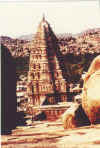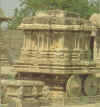|
|
||||
|
Archaeology
Banking & Management
Adventure & Outdoors
Films
Heritage
People
Books Craft Shop
|
|
|
||
|
the-south-asian.com November 2000 |
||||
|
Page 2 of 2
Hampi – World heritage site in danger Saikat Neogi
The grand expanse of the ruins of this once great empire of Vijayanagar lay buried in the sands of time till just a decade ago. Excavations have revealed that Hampi was not merely a monument in stone but a beacon of light shining upon an empire which was far ahead of its times. A pointer to the far-sightedness of the kings is the fact that they established close links with the outside world. Apart from trade with China there were diplomatic and trade links with Persia, Portugal, Italy and Russia. Envoys, traders and tourists from these countries have left behind vivid descriptions of Hampi and its treasures.Apart from the treasures excavated from the site, Hampi is surrounded by over 500 small and big temples, that are frequented even today by devotees from all over the country. Each temple is different from the other in style and architecture. According to local priests some of the ruins of the temples excavated whisper stories of long forgotten eras.
The amazing architecture of the 500 odd temples may be lost forever for they are in a dilapidated condition and could crumble at any point of time. Added to the problems are the ubiquitous encroachments by small traders who are fast ruining the sites. Surprisingly several court orders have tried to uproot the encroachers, but all in vain. Despite the mess created by the encroachers the state Government of Karnataka and the Archaeological Survey of India have taken up extensive conservation work to restore the historically important temples of Krishna and Chandrashekhara.The most important complex is that of the Virupaksha temple which is now being reconstructed after numbering each stone. The main entrance of the temple was constructed by later rulers. This temple was totally submerged in water because it is located at a lower table. The broken beams on the roof have been replaced with new ones. The work of closing the roof with mortar is now being carried out.The Karnataka State Department of Archaeology and Museums has protected and reconstructed a row of mantaps or chariot bazaars the biggest of which was the Therubeddi chariot - 1.6 kilometres long and 50 metres wide. The remains of the chariot can be seen even now. Hampi - stone chariotThe South Indian kingdom of Vijayanagar, was ruled mainly by the Hoysalas. According to historians Harihara and Bukkaraya were the first army captains of Hoysala kings and it was the vision of these generals that laid the foundation for the empire of Vijayanagar. From 1342 to 1565 AD the empire was ruled by the Sangama, Salva, and Tuluva dynasties and it reached its religious, cultural and literary zenith during the reigns of Harihara II and Krishnadevaraya. The Sangama soldiers began their rule from Anegundi on the left bank of the Tungabhadra river, which was also known as Kishikindha in Ramayana. They established a new capital on the west bank of Tungabhadra that was surrounded by tree covered mountains and forests. This later became famous as Vijayanagar. After a glorious two hundred years, Vijayanagar fell in 1565 AD.In a bid to document the remains of the great empire, and to give the tourists a visual journey of the kingdom, a documentary titled Whispering Stones has been made by B. N. Chandra Kanth which will form a part of the state tourism departments guide on Hampi and the latest archaeological findings. But this is not the end of the story. Excavation work is still in progress in Hampi, and more treasures are being unearthed which will go a long way in unravelling the grandeur and glory of the once mighty Vijayanagar empire._____
|
||||
| Copyright © 2000 [the-south-asian.com]. Intellectual Property. All rights reserved. | ||||
| Home |

